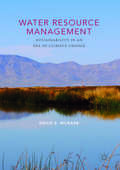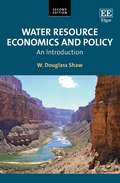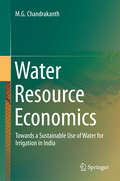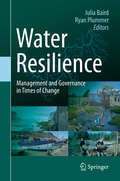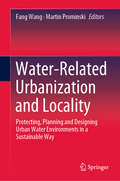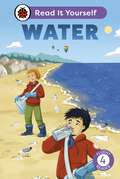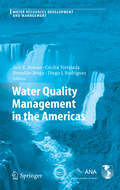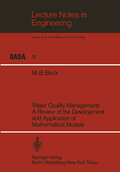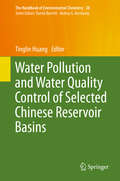- Table View
- List View
Water Resource Management Issues: Basic Principles and Applications
by Louis Theodore R. Ryan DupontDrinking Water Safety: Basic Principles and Applications, examines the technical and scientific, as well as regulatory, ethical, and emerging issues of pollution prevention, sustainability, and optimization for the production and management of safe drinking water to cope with environmental pollution, population growth, increasing demand, terrorist threats, and climate change pressures. It presents a summary of conventional water and wastewater treatment technologies, in addition to the latest processes. Features include: Provides a summary of current and future of global water resources and availability. Summarizes key U.S. regulatory programs designed to ensure protection of water quality and safe drinking water supplies, with details on modern approaches for water utility resilience. Examines the latest water treatment technologies and processes, including separate chapters on evaporation, crystallization, nanotechnology, membrane-based processes, and innovative desalination approaches. Reviews the specialized literature on pollution prevention, sustainability, and the role of optimization in water treatment and related areas, as well as references for further reading. Provides illustrative examples and case studies that complement the text throughout, as well as an appendix with sections on units and conversion constants.
Water Resource Management in Central Asia and Afghanistan: Current and Future Environmental and Water Issues (Springer Water)
by Zheenbek E. Kulenbekov Baktyiar D. AsanovThe book provides a cross-sectoral, multi-scale assessment of development-directed investigations in the main rivers of wider Central Asia and Afghanistan. The book highlights the development of river systems, water reservoirs, ecosystems and risks as well as the impact of climate change on water resources in Central Asian countries and Afghanistan. It provides information on the genesis of river basins, physical and chemical properties of water in rivers, and the hydrological regimes of the rivers of Central Asia and Afghanistan. The book is useful for scientists and researchers whose work focuses on rivers and the use of water resources, irrigation, ecosystems, risks, water supply, climate change and remote sensing, as well as for students and planners, administrations and other stakeholders in the water sector.
Water Resource Management: Sustainability in an Era of Climate Change
by David E. McnabbThis book is about how water managers in the United States are responding to the call for increased effort to achieve sustainable supplies of clean fresh water for present and future generations. The author, himself a participant in the water supply chain, demonstrates that while water is indeed one of life’s most essential commodities, in many parts of the United States it is one of the most stressed resources. Throughout the book the author illustrates both the good and the bad efforts taken or not taken by water and wastewater management with real life examples. This book will appeal to the educators, students, volunteers, elected officials, regulators, and other participants with a role in helping the suppliers of water and wastewater services to achieve their goals providing clean, safe water on a sustainable basis.
Water Resource Management: Sustainability in an Era of Climate Change
by David E. McnabbThis book is about how water managers in the United States are responding to the call for increased effort to achieve sustainable supplies of clean fresh water for present and future generations. The author, himself a participant in the water supply chain, demonstrates that while water is indeed one of life’s most essential commodities, in many parts of the United States it is one of the most stressed resources. Throughout the book the author illustrates both the good and the bad efforts taken or not taken by water and wastewater management with real life examples. This book will appeal to the educators, students, volunteers, elected officials, regulators, and other participants with a role in helping the suppliers of water and wastewater services to achieve their goals providing clean, safe water on a sustainable basis.
Water Resource Economics and Policy: An Introduction
by W. D. ShawEconomic issues arise in almost every water policy context. Water is of most concern when scarce, but physical scarcity is often overcome as human beings move water from place to place, sometimes creating monumental structures. The roles that cost and economic value play in water resource allocation are implicit, but often poorly understood. This second edition clarifies the role of economics and offers material that can be applied to water resource allocation problems around the world. Topics covered include: groundwater, floods and droughts, in situ uses of water, and institutions and law. New to the book is an exploration of water issues outside the United States as well as a new application of behavioral and experimental economics to the topic. A concise introduction to issues of water quality and quantity in both urban and agricultural settings, Water Resource Economics and Policy will be a valuable resource or text for students and researchers in the fields of agricultural economics, geography, law, and hydrology. Those involved in water resource agencies and private utilities will also find the book a useful reference.
Water Resource Economics: Towards a Sustainable Use of Water for Irrigation in India
by M.G. ChandrakanthThis book uses resource economics costing approaches incorporating externalities to estimate the returns for the country’s irrigation and demonstrates how underestimating the cost of water leads farmers to overestimate profits. The importance of the subject can be judged in light of the fact that India is the largest user of groundwater both for irrigation and for drinking purposes, pumping twice as much as the United States and six times as much as Europe.Despite water’s vital role in ensuring economic security for the nation and farmers alike by supporting more than 70% of food production, water resource economists are yet to impress upon farmers and policymakers the true value of water and the urgent need for its sustainable extraction, recharge and use. In an endeavor to promote more awareness, the book further delineates the roles of the demand side and supply side in the economics of irrigation, and explains how the cost of water varies with the efforts to recharge it, crop patterns, degrees of initial and premature well failure and degrees of externalities. It also discusses the importance of micro-irrigation in the economics of saving water for irrigation, estimating the marginal productivity of water and how it improves with drip irrigation, the economics of water sharing and water markets, optimal control theory in sustainable extraction of water, payment of ecosystem services for water and how India can effectively recover.In closing, the book highlights the role of socioeconomic and hydrogeological factors in the economics of irrigation, which vary considerably across hard rock areas and the resulting limitations on generalizing.
Water-resisting Property and Key Technologies of Grouting Reconstruction of the Upper Ordovician Limestone in North China’s Coalfields (Springer Theses)
by Hao WangThis book examines the water resistance capacity of the Upper Ordovician limestone and its feasibility as a water barrier to achieve safe and green mining. Mine water inrush events often occur during coal mine construction and production; they account for a large proportion of the coal mine disasters and accidents in China, second only to gas explosions. As mining depths and mining intensity continue to increase, the hydrogeological conditions encountered are becoming more complex. This book describes in-situ methods designed to test the water resistance of the limestone layer, as well as specific grouting techniques developed to transform this layer into a barrier that can prevent water inrush during mining. The innovative technologies, which were applied and validated in two coal mines, are applicable to other coal mines or any underground engineering works.
Water Resilience: Management and Governance in Times of Change
by Julia Baird Ryan PlummerThis book synthesizes current knowledge and understanding of management and governance in the context of water resilience; advances theory through synthesis of research and experiences from a variety of disciplinary perspectives. The book highlights the implications of theory and experience for innovation in practice and policy; and it explores frontiers and future research. The book further addresses the need for a consolidated, interdisciplinary approach to the theoretical advances and practical implications of water resilience for academics, resource managers, aid organizations, policy makers and citizens.
Water Remediation (Energy, Environment, and Sustainability)
by Shantanu Bhattacharya Akhilendra Bhushan Gupta Ankur Gupta Ashok PandeyThis book presents the state-of-the-art in the area of water remediation. It covers topics such as decentralized ecological wastewater treatment, applications of remote sensing and geographic information systems (GIS) in water quality monitoring and remediation, water remediation through nanotechnology, and processes used in water purification. The contents of this volume will prove useful to researchers, students, and policy makers alike.
Water-Related Urbanization and Locality: Protecting, Planning and Designing Urban Water Environments in a Sustainable Way
by Fang Wang Martin ProminskiThis book discusses the protection, planning, and design of sustainable urban water environments. Against the backdrop of environmental changes, it addresses issues of water resource protection and sustainable development in China and Germany at different stages of urbanization, as well as relevant strategies and lessons learned. It focuses on three topics: balance between water environment protection and utilization in the urbanization process; sustainable use of water resources in the urbanization process; and water-related planning and design strategies in urbanization and local cultural development processes. In the context of water resources, China and Germany can learn from each other’s experiences and can support one another in the fields of urbanization and locality. As such, the book brings together Chinese and Germans scientists from various disciplines, such as planning, geography, landscape, architecture, tourism, ecology, hydraulic engineering and history to provide a multicultural and multidisciplinary perspective on the topic and examine the challenges and opportunities as well as the planning and design strategies to achieve sustainable, water-related urban spaces. By combining theoretical and practical approaches, it appeals to academics and practitioners around the globe.
Water: Read It Yourself - Level 4 Fluent Reader (Read It Yourself)
by LadybirdHumans, animals, and plants need water every day to survive. But where does it come from? How do we know if it is safe to drink? Learn all about how water is saved, cleaned, and shared in this fact-filled book. Water is from Fluent Reader Level 4 and is ideal for more fluent readers aged from 7+ who are starting to read independently.Each book has been carefully checked by educational and subject consultants and includes comprehension puzzles, book band information, and tips for helping children with their reading. With five levels to take children from first phonics to fluent reading and a wide range of different stories and topics for every interest, Read It Yourself helps children build their confidence and begin reading for pleasure.
Water Quality Monitoring Network Design (Water Science and Technology Library #33)
by Nilgun B. Harmanciogammalu O. Fistikoglu S.D. Ozkul V.P. Singh M.N. AlpaslanIn recent years, the adequacy of collected water quality data and the performance of existing monitoring networks have been seriously evaluated for two basic reasons. First, an efficient information system is required to satisfy the needs of water quality management plans and to aid in the decision-making process. Second, this system has to be realized under the constraints of limited financial resources, sampling and analysis facilities, and manpower. Problems observed in available data and shortcomings of current networks have led researchers to focus more critically on the design procedures used. The book is intended to present an up-to-date overview of the current network design procedures and develop basic guidelines to be followed in both the design and the redesign of water quality monitoring networks. The book treats the network design problem in a comprehensive and systematic framework, starting with objectives of monitoring and elaborating on various technical design features, e.g. selection of sampling sites, sampling frequencies, variables to be monitored, and sampling duration. The design procedures presented are those that the authors have recently applied in a number of national and international projects on the design and redesign of water quality monitoring networks. Thus, the book covers real case studies where not only the methods described in the earlier titles are used but also new techniques are introduced. Where earlier methods are used, they are assessed with respect to their efficiency and applicability to real case problems. Audience: Essentially, the framework adopted in the book applies as well to other hydrometric data collection networks besides those of water quality. In this respect, it is expected that planners, designers, scientists, and engineers who are involved in hydrometric network design will benefit from the in-depth approach assumed in this book. It will also be of interest to research and data centers, international programs and organizations related to environmental monitoring. The book may also be used as a reference text in graduate courses of water resources and environmental engineering programs.
Water Quality Modelling for Rivers and Streams (Water Science and Technology Library)
by Marcello Benedini George TsakirisThe main objective of the Water Framework Directive in the European countries is to achieve a “good status” of all the water bodies, in the integrated management of river basins. In order to assess the impact of improvement measures, water quality models are necessary. During the previous decades the progress in computer technology and computational methods has supported the development of advanced mathematical models for pollutant transport in rivers and streams. This book is intended to provide the fundamental knowledge needed for a deeper understanding of these models and the development of new ones, which will fulfil future quality requirements in water resources management. This book focuses on the fundamentals of computational techniques required in water quality modelling.Advection, dispersion and concentrated sources or sinks of contaminants lead to the formulation of the fundamental differential equation of pollutant transport. Its integration, according to appropriate initial and boundary conditions and with the knowledge of the velocity field, allows for pollutant behaviour to be assessed in the entire water body. An analytical integration is convenient only in one-dimensional approach with considerable simplification. Integration in the numerical field is useful for taking into account particular aspects of water body and pollutants.To ensure their reliability, the models require accurate calibration and validation, based on proper data, taken from direct measurements. In addition, sensitivity and uncertainty analysis are also of utmost importance. All the above items are discussed in detail in the 21 chapters of the book, which is written in a didactic form for professionals and students.
Water Quality Modeling That Works
by Wu-Seng LungThis book offers a practical guidance for environmental engineers and scientists charged with assessing the cause-and-effect of pollutants in receiving water systems. Instead of blindly running models, which is a practice seen too often in today’s field that can result in results with uncertainty, modelers must first understand the physical insights of the specific water systems in order to properly calibrate the parameters of the models. This book reinforces the critical importance of properly understanding the physical attributes of water systems by drawing on the author’s extensive experience in modeling with strong data support. This is also what sets this book apart from the volumes currently available in the water quality modeling field – nearly all other books in the field are categorized as textbooks, and unlike this book, offer few practical examples or exercises to follow. Environmental engineers and scientists engaged in quantifying the water quality impacts of pollutants to specific water systems will find this book valuable in their day-to-day practices. This book is a necessary volume for water quality engineers and scientists to consult for the regulatory planning and management of water systems
Water Quality Management in the Americas (Water Resources Development and Management)
by Asit K. Biswas Cecilia Tortajada Benedito Braga Diego J. RodriguezThis study presents for the first time an independent and authoritative analysis of water quality management in North and South America, and discusses the practices and future implications of the impacts of the current practices in the different countries of the hemisphere. Includes in-depth case studies analyzing water quality management practices at country and state levels, especially in terms of their effectiveness and overall impact.
Water Quality Management: Assessment and Interpretation (SpringerBriefs in Water Science and Technology)
by Gholamreza AsadollahfardiConsidering the significance of water quality for drinking, irrigation and industry, availability of accurate and sufficient water quality data is necessary and having enough data without proper interpretation is not helpful for water quality management decisions.Hence, analysis of the existing data and prediction of future of water quality is vital. The current volume first defines the importance of water quality parameters regarding public health and irrigation. Secondly, the climatic situation and hydrological cycle of the area is considered for interpretation of the data.Various methodologies such as Box-Jenkins time series analysis, water quality indices, artificial neural networks and principal component analysis are described and applied to actual data for different environmental conditions such as arid, semiarid and mountainous areas.This book is a user manual for students and professionals involved in water quality planning and management.
Water Quality Management: A Review of the Development and Application of Mathematical Models (Lecture Notes in Engineering #11)
by M.B. BeckDuring 1978-1982 the International Institute for Applied Systems Analysis (IIASA) was responsible for a research project on Environmental Quality Control and Management. The project was begun under the direction of Professor O. F. Vasiliev (from the Institute of Hydrodynamics of the Siberian Branch of the USSR Academy of Sciences) and was subsequently led by myself. This review is very much a re'fiection of that IIASA project. The major themes of the IIASA project were: (i) research into the methodological aspects of modeling river and lake sys tems [some of the principal results of this research appear in M. B. Beck and G. van Straten (eds. ) (1983), Uncertainty and Forecasting of Water Quality (Springer, Berlin (West)), and in K. Fedra (1983), Environmental Modeling Under Uncertainty: Monte Carlo Simulation (IIASA Research Report RR-83-28)]; (ii) case studies in the application of mathematical models to lake eutrophi cation control [results of which are summarized in L. Somlyody, S. Hero dek, and J. Fischer (eds. ) (1983), Eutrophication of Shallow Lakes: Model ing and Management (The Lake Balaton Case Study) (IIASA Collaborative Proceedings CP-83-S3), and in K. Fedra (1983), A Modular Approach to Comprehensive System Simulation: A Case Study of Lakes and Watersheds (in W. K. Lauenroth, G. V. Skogerboe, and M. Flug (eds. ), Analysis of Ecological Systems: State-of-the-Art in Ecological Modelling, pp. 195-204. Elsevier, Amsterdam)]; iv (iii) a policy study of operational water qua,lity management [M. B. Beck (1981), Operational Water Quality Management: Beyond Planning and Design (IIASA Executive Report ER-7)].
Water-Quality Hydrology (Water Science and Technology Library #16)
by Vijay P. Singh and Bhishm KumarWater is vital to life, maintenance of ecological balance, economic development, and sustenance of civilization. Planning and management of water resources and its optimal use are a matter of urgency for most countries of the world, and even more so for India with a huge population. Growing population and expanding economic activities exert increasing demands on water for varied needs--domestic, industrial, agricultural, power generation, navigation, recreation, etc. In India, agriculture is the highest user of water. The past three decades have witnessed numerous advances as well as have presented intriguing challenges and exciting opportunities in hydrology and water resources. Compounding them has been the growing environmental consciousness. Nowhere are these challenges more apparent than in India. As we approach the twenty first century, it is entirely fitting to take stock of what has been accomplished and what remains to be accomplished, and what accomplishments are relevant, with particular reference to Indian conditions.
Water Quality: An Introduction (Aquaculture Ser.)
by Claude E. BoydThe revised second edition updates and expands the discussion, and incorporates additional figures and illustrative problems. Improvements include a new chapter on basic chemistry, a more comprehensive chapter on hydrology, and an updated chapter on regulations and standards. This book presents the basic aspects of water quality, emphasizing physical, chemical, and biological factors. The study of water quality draws information from a variety of disciplines including chemistry, biology, mathematics, physics, engineering, and resource management.University training in water quality is often limited to specialized courses in engineering, ecology, and fisheries curricula. This book also offers a basic understanding of water quality to professionals who are not formally trained in the subject.Because it employs only first-year college-level chemistry and very basic physics, the book is well-suited as the foundation for a general introductory course in water quality. It is equally useful as a guide for self-study and an in-depth resource for general readers.
Water Quality: An Introduction
by Claude E. BoydWater quality is important to everyone, but professionals in many disciplines need an understanding of this subject. Although water quality is complex, its general aspects can be grasped readily and with little background - only introductory chemistry and biology and a little algebra are needed. Unfortunately, the teaching of water quality is not well organized. In most colleges and universities, water quality instruction is given in certain engineering curricula and in aquatic ecology or fisheries curricula. There also is brief attention to selected topics on water quality in numerous classes in other curricula. Water quality training in engineering is highly specialized and directed by necessity towards water supply and water treatment, while the focus in aquatic ecology and fisheries is on biological water quality and pollution. Few students venture into specialized classes outside of their curricula, and as a result, their formal training in water quality is greatly restricted. Self-education by reading texts and reference books on water quality is difficult. Authors of water quality books seem to be more interested in presenting a rigorous, detailed treatment than in focusing on simplicity and clarity. Chemical aspects of water quality often are presented at a level requiring fairly advanced mathematics and physical chemistry, and biological discussions may be quite advanced and theoretical. I have taught water quality to seniors and graduate students in agriculture, wildlife and fisheries, environmental sciences, economics, and similar disciplines for many years.
Water Quality: An Introduction
by Claude E. BoydThis volume is of great importance to humans and other living organisms. The study of water quality draws information from a variety of disciplines including chemistry, biology, mathematics, physics, engineering, and resource management.University training in water quality is often limited to specialized courses in engineering, ecology, and fisheries curricula. This book also offers a basic understanding of water quality to professionals who are not formally trained in the subject.The revised third edition updates and expands the discussion, and incorporates additional figures and illustrative problems. Improvements include a new chapter on basic chemistry, a more comprehensive chapter on hydrology, and an updated chapter on regulations and standards.Because it employs only first-year college-level chemistry and very basic physics, the book is well-suited as the foundation for a general introductory course in water quality. It is equally useful as a guide for self-study and an in-depth resource for general readers.
Water Poverty: The Next “Oil” Crisis
by Shirley J. HansenA water crisis on our immediate horizon is destined to hurt, even kill, millions of children, and the window of opportunity to do something about it is rapidly closing. There is, however, a glimmer of hope that could turn into rays of sunshine. Water is a commodity, and we have just come through some painful times dealing with the shortage of another commodity—energy. For those who lived through the "energy crisis," this book offers a brief trip down memory lane.
Water Pollution and Water Quality Control of Selected Chinese Reservoir Basins (The Handbook of Environmental Chemistry #38)
by Tinglin HuangThis volume provides a detailed overview of water pollution and control of several selected Chinese reservoirs. It explores sediment contamination as well as algal blooms and their impact on water quality. Several chapters also discuss various methods of quality control, such as mixing-oxygenation combined with microbial remediation technologies. Due to their broad geographical distribution and different nutrition levels, the investigated reservoirs, the Jinpen, Shibianyu, Fenhe, Zhelin and Zhoucun reservoirs, can be regarded as representative for China. This comprehensive work will appeal to researchers, advanced students and reservoir managers.
Water Pollution and Remediation: Photocatalysis (Environmental Chemistry for a Sustainable World #57)
by Inamuddin Mohd Imran Ahamed Eric LichtfouseIn the context of climate change and fossil fuel pollution, solar energy appears as a cheap and sustainable fuel for many environmental applications, yet the efficiency of techniques has to be improved. This book reviews recent methods and applications of photocatalysis for the treatment of wastewater containing bacteria, heavy metals, organic pollutants, dyes and tannery effluents. Basics of water pollution, polluted river ecosystems and membranes are also detailed.
Water Pollution (The Handbook of Environmental Chemistry #5 / 5A)
by B. Allard G. F. Craun N.T. de Oude M. Falkenmark H. L. Golterman T. Lindstrom W. T. PiverThe Handbook of Environmental Chemistry provides the compilation of today's knowledge of processes in the natural environment and the behavior and impact of pollutants. It provides a valuable source for environmental managers, decision-makers, and scientists. Volume 5A is dedicated to water pollution.


